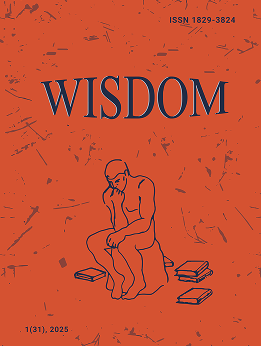Philosophy of Red Color: Lingual and Extralingual Aspects
DOI:
https://doi.org/10.24234/wisdom.v15i2.342Keywords:
psycholinguistics, perception, color name, lingual, extra lingual, idiom, phraseological unitAbstract
This article analyses various lingual and extra lingual researches on a red color, comparing the symbolic meanings of color, which used to be and still are specific for different cultural communities. The objective of the article is to identify peculiarities in the interpretation of red color in the subjective world of sensation and the objective world of fact and to provide the full study of this color perception and categorization based on phraseology.
Color lexis (including English phraseology) is a multidimensional phenomenon. It accumulates in itself the significant experience of society and the numerous stages of world knowledge by man. Having arisen at a certain stage of the development of the language system, color names at a conceptual level demonstrate a vivid example of a change in the process of cognition of the world by a person, confirms the thesis about the need for multi interval thinking, which allows one to observe any object from different cognitive positions.
The main conclusion of the article is that the study of the relations between lingual and extra lingual meanings of color in the semantics of idioms is the most important task of anthropocentric phraseology because in language are fixed and phraseologized precisely those figurative expressions that are associated with cultural and national standards, stereotypes, mythologisms for a certain community mentality, which serves as its spiritual equipment, psychological tool.
Downloads
References
Brent, B., & Kay, P. (1969). Basic Color Terms: Their Universality and Evolution. Berkeley: University of California Press.
Birren, F. (1961). Color Psychology and Color Therapy: A Factual Study of the Influence of Color on Human Life. New Hyde Park, N.Y.: University Books.
Birren, F. (1987). Principles of Color. West Chester. PA: Schiffer.
Bonfiglio, P. T. (2017). The Psychopathology of American Capitalism. Richmond: University of Richmond.
Durbin, M. (1972). Basic Terms – Off-Color. Semiotica. 6, 257-278.
Everett, C. (2013). Linguistic Relativity. Evidence Across Languages and Cognitive Domains. Berlin: Mouton de Gruyter.
Frumkina, R. ?. (1984). Tsvet, smysl, skhodstvo: aspekty psikholingvisticheskogo analiza (Color, Meaning, Similarity: Aspects of Psycholinguistic Analysis, in Russian). Moscow: Nauka.
Gaiduk, V. P. (1971). K voprosu o tsvetovoi simvolike “Bozhestvenoi Komedii” Dante (On the Color Symbolism of the “Divine Comedy” by Dante, in Russian). Moscow: Nauka.
Goethe, J. W. (1964). Izbrannye filosofskie proizvedeniya (Selected Philosophical Works, in Russian). ?oscow: Nauka.
Gonikman, E. I. (1997). Odezhda i kamni kotorye lechat (Clothes and Stones that Cure, in Russian). Moscow: Izdatel’skii dom MSP.
Grose, F. (1785). The Classical Dictionary of the Vulgar Tongue. London.
Harper, D. (2020). Online Etymology Dictionary. Retrieved June 1, 2020 from: https://www.etymonline.com/word/red.
Harris, M. (2015, May). Does Color Even Exist? The New Republic, 22. Retrieved June 1, 2020 from: https://newrepublic.com/article/121843/philosophy-color-perception.
Humeniuk, ?. ?. (2010). Frazeologichnist koloratyviv (na materiali angliiskoi movy) (Phraseologicalness of Color Names (On the Material of English Phraseology, in Ukrainian). New Filology, 38, 171-178.
Humeniuk, ?. ?. (2008). Symvolika koloropoznachen u skladi frazeologichnyh odynyts dlia vyrazhenia kontseptu emotsii ta pochuttiv (na materiali angliiskoi movy) (Symbolism of Color Terms As Part of Phraseological Units for Expressing the Concept of Emotions and Feelings (Based on English Material), in Ukrainian. Scientific Bulletin of Chernivtsi University. 370-371, 30-35.
Kriulina, A. A. (Ed.) (1993). Tsvet v nashei zhizni (Color in Our Life, in Russian). Kursk: Kurskin-formpechat.
Kudriavtseva, N. S. (2011). Hipoteza lingvistychnoi vidnosnosti: za i proty (Hypothesis of Linguistic Relativity: Pros and Cons, in Ukrainian). Scientific Proceedings, 95(1), 69-75.
Porozhniuk, ?. (2000). Chervona barva v movnii palitri (Red Color in Language Palette, in Ukrainian). Ukrainian Lesson, 1, 28-29.
Turner, V. U. (1983). Simvol i ritual (Symbol and Ritual, in Russian). ?oscow: Nauka.
Wierzbicka, A. (1997). Yazyk. Kultura. Poznanie (Language. Culture. Cognition, in Russian). ?oscow: Ruskie slovari.
Wierzbicka, A. (2006). The Semantics of Color: A New Paradigm. In C. P. Biggam & C. J. Kay (Eds.), Progress in Colour Studies. Volume I: Language and Culture (pp. 1-24). Amster-dam and Philadelphia: John Benjamins Publishing Company.
Yanshin, P. V. (1996). Emotsional’nyi tsvet: emotsional’nyi component v psikhologicheskoi structure tsveta (Emotional Color: the Emotional Component in the Psychological Structure of Color, in Russian). Samara: Samara University Publishment.
Downloads
Published
How to Cite
Issue
Section
License
Copyright (c) 2020 WISDOM

This work is licensed under a Creative Commons Attribution-NonCommercial 4.0 International License.
Creative Commons Attribution-Non-Commercial (CC BY-NC). CC BY-NC allows users to copy and distribute the article, provided this is not done for commercial purposes. The users may adapt – remix, transform, and build upon the material giving appropriate credit, and providing a link to the license. The full details of the license are available at https://creativecommons.org/licenses/by-nc/4.0/.















